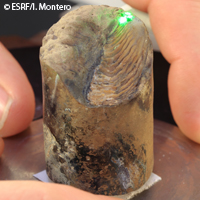Plankton diet sealed ammonites' fate, study suggests
Palaeontologists have long loved the ammonite, one of the planet's most important index fossils. The extinct cousins of octopuses, squid and cuttlefish, the ammonites were marine molluscs that swam in our seas for 350 million years before becoming extinct 65.5 million years ago. Despite their popularity, however, little was known about what ammonites ate - until now. Writing in the journal Science, a Franco-US team of researchers presents direct evidence that ammonites' diet consisted of plankton. The discovery sheds new light on the causes of these creatures' extinction. Using the European Synchrotron Radiation Facility (ESRF) in Grenoble, France, the researchers generated stunning three-dimensional (3D) X-ray images that reveal the mouthparts of three ammonite species discovered in the US state of South Dakota, an area that attracts fossil lovers from all over the world. The images also show the remains of what the ammonites last dined on: plankton. Past studies have found that that the same asteroid impact that triggered the extinction of dinosaurs also caused plankton levels to plummet. So failure to secure food led to the ammonites' extinction, the team suggests. The 3D reconstructions provide a first-rate look into the jaws and teeth of the ammonites. The researchers even discovered that one specimen contains a tiny snail and three crustaceans in its mouth. 'The fossil specimens of Baculites, one of the few ammonite genera that persisted up to and perhaps even across the Cretaceous-Palaeogene boundary' had jaws and radula, a kind of tongue that is covered with teeth, according to the team. They found that the tallest cusp of the radula is 2 millimetres high, and the shape of the teeth, which are very slender, vary from sabre to comb-like. They point out that because these planktonic fossils are not visible anywhere else on the specimen, the ammonite must have died while it consumed its last meal 'rather than being scavenged by these organisms after death'. Lead author Isabelle Kruta from the Muséum National d'Histoire Naturelle (MNHN) in France says: 'I was astonished when I saw the teeth for the first time, and when I found the tiny plankton in the mouth. For the first time we were able to observe the delicacy of these exceptionally well preserved structures and use high quality details to obtain information on the ecology of these enigmatic animals.' Co-author Dr Neil Landman from the American Museum of Natural History in New York, US, comments: 'When you take into consideration the large lower jaws of ammonites in combination with this new information about their teeth, you realise that these animals must have been feeding in a different way from modern carrion-eating Nautilus. Ammonites have a surprisingly large lower jaw with slender teeth, but the effect is opposite to that of the wolf threatening to eat Little Red Riding Hood. Here, the bigger mouth facilitates feeding on smaller prey.' Dr Landman goes on to say that their research indicates a number of things including that the radiation of aptychophoran ammonites might be linked to the radiation of plankton during the Early Jurassic. The results could also help scientists fuel people's understanding of carbon cycling during this period. Commenting on the use of X-ray synchrotron microtomography, the ESRF's Paul Tafforeau, who also co-authored the study, says it is the most sensitive technique for investigating the internal structures of fossils without the risk of damaging them. 'It started 10 years ago with primate teeth, but is now widely applied in palaeontology', he says. 'We made a first test on one of the ammonite specimens after a test with a conventional scanner failed, and the results were so impressive that we scanned all the other available samples, discovering nearly each time a radula and for one of them, many other structures.' Isabelle Rouget from Laboratoire de Paléontologie, Université Pierre et Marie Curie in Paris, who also contributed to the study, remarks: 'We now realise that ammonites occupied a different niche in the trophic web than we previously thought.'For more information, please visit: European Synchrotron Radiation Facility (ESRF):http://www.esrf.eu/Muséum National d'Histoire Naturelle (MNHN):http://www.mnhn.fr/ American Museum of Natural History:http://www.amnh.org/Science:http://www.sciencemag.org/
Countries
France, United States



